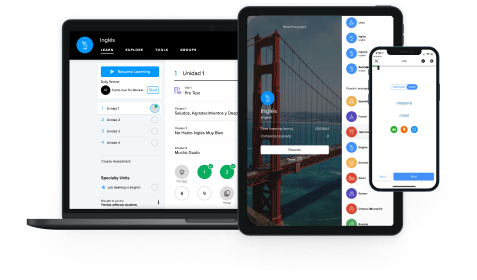
8 Tips for Giving Better Corrective Feedback to our Language Learners
Frustrated that your feedback doesn’t seem to “sink in” for your language students?
If you’re like most teachers, you probably put a lot of time and effort into providing thoughtful feedback to your students. And it can be really frustrating when you don’t see them learning and growing from it in the way that you’d hope or expect. The good news is that there are some very simple ways to make your feedback really sink in for your students. In this article, we’re sharing with you 8 easy, experience-based teaching tips – and they all come down to something called “Corrective Feedback.”

So, what is Corrective Feedback?
Corrective Feedback – a pedagogical term which means exactly what it sounds like: feedback given for the purpose of correcting errors.
At one point or another, we’ve all received Corrective Feedback.
To illustrate this, think back to a time when you were in class (maybe a language class – or maybe another subject) when a teacher identified an error you made and corrected you on it. What was the error? How did the teacher correct it? In what ways was the feedback helpful? In what ways unhelpful? Hold on to that memory – and we’ll come back to it later. Now, let’s dive into the tips that will help you optimize your Corrective Feedback for your language learners...
Tip #1: Prioritize your feedback.
Sometimes, less is more. This is especially true for the written feedback we give our students. We’ve all been there, providing feedback that ends up with too much red ink. Too many scattered comments. Problem is, that serves to overwhelm the learner. And it’s costly to your time. The solution is to prioritize your feedback. Tell the learner what’s most important. Let’s say you’ve just read a student’s essay. The first thing you should do is write a summary of the 3-4 main areas of improvement that the student should focus on. Avoid adding a plethora of specific, sentence-level comments throughout the body of the essay. Instead, simply circle the associated problem areas without specifying what it is that they need to fix in each of those spots. It’s up to the student to identify why it’s wrong and how to fix it before turning in the revised version for their final grade. In short, prioritizing your feedback (a) encourages students to engage in self-directed critical thinking and (b) allows you to be more efficient with your time.

Tip #2: Feedback first, grade later.
To make sure your students actually read your feedback, provide it before assigning grades. If you’re only providing feedback after assigning students’ grades, there’s less incentive for them to thoroughly read and internalize it. For example, you could set up your assignment structure such that students always submit a rough draft before their final papers – and you grade it for completion only. That part is important. Then they incorporate that feedback into their final submission, which is where they get their final grade for the assignment. Formative, low-stakes assignments like this that are graded for completion) reduce student grade anxiety, which can in turn, promote a culture of joy in the learning process. And here’s a really amazing added benefit: doing this might even encourage them to get a little more adventurous with the target language. For example, they’ll be more likely to try out more complex grammar in their writing, because they won’t feel the need to worry that their attempt at trying something more difficult (which means more prone to errors) could result in getting docked points.

Tip #3: Maintain a timely turnaround.
Delayed feedback is counterproductive to the learning process because it allows student errors to become entrenched. We all know this one. It’s as obvious and it is well-documented in language learning research. Students submit an assignment or an exam, and in an ideal world, you plan to get it back to them the following day. The problem is that life presents many competing demands on your time, which can get in the way. To help with that, here are two suggestions. Suggestion #1: Put grading/feedback time on your calendar so it’s protected time. If that doesn’t work for you, consider Suggestion #2: implement online quizzes that provide automatic feedback. You can even curate the quiz experience for them, such that when they select an incorrect answer, they get a short text description that explains why it’s incorrect. Pro-tip – Tip #1 (providing feedback summaries as opposed to feedback details) will also help you improve your feedback turnaround!

Tip #4: Never underestimate the power of positive feedback!
Positive and negative feedback are both critical to the learning process. Together, they increase student efficacy (that results from positive feedback) while also encouraging learner growth (that comes from negative feedback). In theory, this should be such an easy tip to implement, but it’s easy to forget when you’re in the thick of grading and providing feedback. To keep yourself accountable, try putting a sticky note next to your computer screen that says “Start positive.” Only once you’ve done that will you allow yourself to dive into all that the student can improve. Easy fix!

Tip #5: Address common errors together in class.
Not all errors are specific to individual students. So, share those common error patterns with the class! Post-test debriefs are a great way to do this. And you can even help illustrate key points for them by showing some data. For example, you could say “75% of you got Question #4 wrong – can you tell me why – and how to fix it?” A fun in-class assignment that pairs well with this practice is having students create future exam questions that focus on the common errors they collectively experienced. Creating those questions will help them internalize the takeaway points and (bonus!) provide you with ideas for future questions on exams for the next academic year! Though, if you go that route, make sure to give students the option to opt-in or opt-out of having their submission considered for use on future exams, since it’s their work.

Tip #6: Get meta with your oral feedback methods.
At the beginning of the semester, tell your students how you’ll be providing oral feedback in class. No need to keep it a secret from them! Sharing your methodology with them help them build metacognitive skills and “take the wheel” for their own language learning journey. It also demonstrates to them that you’re intentional with your feedback, which builds collective trust. For example, add a section in your syllabus that outlines your methods. It could go something like this:

“One strategy you’ll notice me using often in class is called recasting, which means I’ll repeat what you’ve said but subtly correct the error you made. Example:
STUDENT: “Yesterday, I waved at he.”
TEACHER: Oh – yesterday, you waved at him?
Tip #7: Encourage students to “play teacher.”
We all know that teachers aren’t the only ones in the room with useful knowledge to contribute. And we also know that students feel a sense of accomplishment when they can help each other. So, encourage student-to-student feedback! One way you can systematically do this is by implementing peer review into your class structure. You could also require students to submit a short paragraph with their final essays or projects that details how they incorporated peer feedback into their final submission. This will help reinforce the corrective feedback in the mind of the learner. Peer review has been shown to foster a more student-driven classroom, which has the added benefit of increased learner motivation.

Plus, sometimes hearing corrective feedback from a friend or classmate hits different than hearing it from a teacher, so lean into the varied expertise in your classroom!
Tip #8: Manage your expectations about student progress.
Remember – it takes some failure before progress is made. Just because a student keeps forgetting the same vocab word or because they seem to keep making the same grammar mistakes — doesn’t mean they’re not learning. It doesn’t mean you’re a bad teacher. Those learning points are likely marianating in their mind – and that can take time. Learning a language is a complicated process, and they’ll get there bit by bit. Sometimes it’s one step forward and two steps back – but sometimes, that’s the name of the game.

Let’s review! Our 8 Tips for giving Corrective Feedback were...
Prioritize your feedback.
Feedback first, grade later.
Maintain a timely turnaround.
Never underestimate the power of positive feedback!
Address common errors together in class.
Get meta with your oral feedback methods.
Encourage students to “play teacher.”
Manage your expectations about student progress.
Time to reflect:
At the beginning of the article, you recalled a time a teacher gave you corrective feedback. Given the tips outlined in this article, how might that teacher have improved the way they gave you that feedback? Just imagine how much better we as teachers would be if we all took this time (that you’ve taken today) to reflect on our past experiences as students and apply new knowledge to better serve our students today?
Tell us - which of these tips are you feeling inspired to try out?
Disclaimer: you shouldn’t feel like you need to implement all 8. In fact, we recommend that you start with just your favorite 2-3. Not every tip will work for your teaching style, so use what works for you! Thanks for reading along with us! And remember – if you have a language question or an idea for an article you’d like to see from us, let us know! We’re always listening. Au revoir! さようなら! We look forward to seeing you back here next time!
Mango For Education